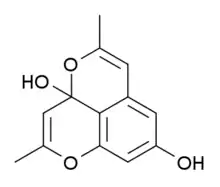Barakol
Barakol is a compound found in the plant Senna siamea,[1] which is used in traditional herbal medicine. It has sedative and anxiolytic effects.[2][3] There are contradictory pharmacological research findings concerning the toxicity of Cassia siamea and the active ingredient Barakol. One pharmacological study has shown an hepatoxic effect of Barakol [4] while another study did not show any toxic effect at a daily dosage intake.[5] Further research is needed to verify whether there are toxic effects of Barakol or not.
 | |
| Clinical data | |
|---|---|
| ATC code |
|
| Identifiers | |
| |
| CAS Number | |
| PubChem CID | |
| ChemSpider | |
| UNII | |
| CompTox Dashboard (EPA) | |
| Chemical and physical data | |
| Formula | C13H12O4 |
| Molar mass | 232.235 g·mol−1 |
| 3D model (JSmol) | |
| |
| |
| | |
References
- Padumanonda T, Gritsanapan W (March 2006). "Barakol contents in fresh and cooked Senna siamea leaves". The Southeast Asian Journal of Tropical Medicine and Public Health. 37 (2): 388–93. PMID 17125004.
- Thongsaard W, Pongsakorn S, Sudsuang R, Bennett GW, Kendall DA, Marsden CA (January 1997). "Barakol, a natural anxiolytic, inhibits striatal dopamine release but off uptake in vitro". European Journal of Pharmacology. 319 (2–3): 157–64. doi:10.1016/S0014-2999(96)00850-3. PMID 9042586.
- Sukma M, Chaichantipyuth C, Murakami Y, Tohda M, Matsumoto K, Watanabe H (November 2002). "CNS inhibitory effects of barakol, a constituent of Cassia siamia Lamk". Journal of Ethnopharmacology. 83 (1–2): 87–94. doi:10.1016/S0378-8741(02)00206-4. PMID 12413711.
- Hongsirinirachorn M, Threeprasertsuk S, Chutaputti A (June 2003). "Acute hepatitis associated with Barakol". Journal of the Medical Association of Thailand = Chotmaihet Thangphaet. 86 (Suppl 2): S484-9. PMID 12930029.
- Wahjoedi B, Pudjiastuti P, Nuratmi B, Sundari D, Chozin A (December 1999). "Toksisitas Subkronik Ekstrak Etanol Daun Johar (Cassia Siamea Lamk.) Pada Tikus Putih [The subchronic toxicity study of the ethanolic extract of Cassia siamea lamk leaf (daun johar) on albino rats]". Bulletin of Health Research = Buletin Penelitian Kesehatan = National Institute of Health Research and Development - Ministry of Health of Republic of Indonesia. 27 Suppl. 3 & 4: S325–332.
This article is issued from Wikipedia. The text is licensed under Creative Commons - Attribution - Sharealike. Additional terms may apply for the media files.